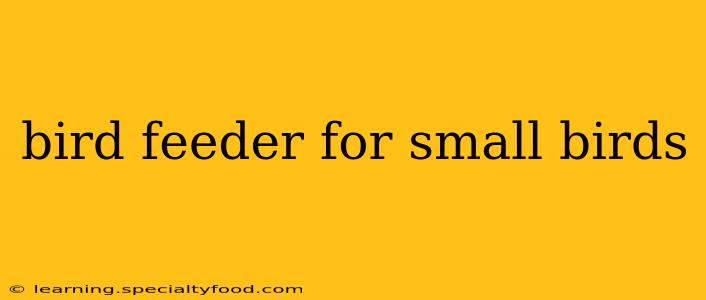Attracting small birds to your garden is a rewarding experience, bringing vibrant color and cheerful song to your outdoor space. But choosing the right bird feeder is crucial. Different feeders cater to different species and feeding preferences. This guide will help you select the perfect feeder to attract a lively flock of tiny feathered friends.
What are the best types of bird feeders for small birds?
Small birds, like chickadees, finches, and wrens, have different needs than larger birds. They often prefer feeders that offer easy access to small seeds and suet. Some excellent options include:
- Tube feeders: These are popular because they protect the food from the elements and larger birds. Look for feeders with small perches and multiple feeding ports to accommodate several small birds at once.
- Tray feeders: Simple and open, these feeders provide easy access to food but are more vulnerable to larger birds and weather conditions. They are best used in areas somewhat sheltered from the elements.
- Suet feeders: Small birds love suet, a high-energy food source, especially during winter. Suet feeders come in various designs, some with cages to protect the suet from squirrels and larger birds.
- Platform feeders: Similar to tray feeders, but often smaller and designed to prevent larger birds from landing. These can be a good option, but again, consider weather protection.
What kind of birdseed should I use for small birds?
The type of seed you choose significantly impacts which birds you attract. Small birds often prefer:
- Nyjer (thistle) seeds: Tiny seeds that are a favorite among goldfinches and other small finches. Use specialized feeders designed for nyjer seeds to prevent spillage.
- Sunflower seeds (black oil): A popular choice for many small bird species, providing essential nutrients and energy.
- White proso millet: A less expensive option, favored by sparrows and ground-feeding birds.
Avoid using cracked corn or large seeds, as small birds may have difficulty handling them.
How do I keep squirrels away from my small bird feeder?
Squirrels are notorious for raiding bird feeders. Here are some strategies to keep them away:
- Squirrel-resistant feeders: These feeders have features designed to deter squirrels, such as cages, baffles, or weight-activated closures.
- Strategic placement: Mount your feeder away from branches or other structures that squirrels could use to access it.
- Spicy pepper spray: Some bird enthusiasts use a mild pepper spray solution around the feeder to deter squirrels without harming birds.
What is the best location for a small bird feeder?
Placement is key for attracting birds and keeping them safe. Consider these factors:
- Shelter from the elements: Position your feeder in a location that offers protection from rain, snow, and strong winds.
- Predator protection: Keep the feeder away from bushes or tall grasses where cats or other predators could hide.
- Easy access for birds: Place the feeder where birds can easily approach it, ideally near a tree or bush for perching.
- Visibility: Choose a location where you can easily observe the birds visiting your feeder.
How often should I refill my small bird feeder?
Refilling frequency depends on the size of your feeder, the number of birds visiting, and the type of food you're using. As a general rule, aim to refill your feeder whenever it's about half empty to ensure a constant supply of food for your feathered friends. Always check for spoiled or moldy food and remove it regularly.
How do I clean my small bird feeder?
Regular cleaning is essential to prevent the spread of disease among birds. Thoroughly wash your feeder with warm, soapy water at least once a month, or more often during warm, humid weather. Rinse thoroughly and allow the feeder to completely dry before refilling.
By carefully considering the type of feeder, seed, location, and maintenance, you can create a thriving bird habitat in your backyard and enjoy the delightful company of small birds for years to come. Remember to always prioritize the birds' well-being and safety when setting up your feeder.
